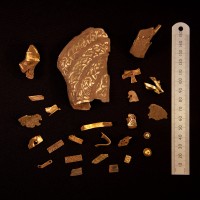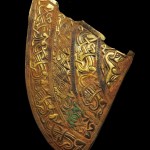New finds made in Staffordshire Hoard field
 In the same field in Hammerwich where three years ago metal detectorist Terry Herbert found the massive 3,900-piece collection of Anglo-Saxon gem-studded gold and silver known as the Staffordshire Hoard, archaeologists have now found another 90 pieces of gold and silver. Archaeologists excavated the find site right after the initial discovery in 2009 and thought they had recovered everything there was to find. The dig was closed.
In the same field in Hammerwich where three years ago metal detectorist Terry Herbert found the massive 3,900-piece collection of Anglo-Saxon gem-studded gold and silver known as the Staffordshire Hoard, archaeologists have now found another 90 pieces of gold and silver. Archaeologists excavated the find site right after the initial discovery in 2009 and thought they had recovered everything there was to find. The dig was closed.This November the field was plowed for the first time since the discovery. On November 19th, a team of archaeologists aided by metal detectorists with experience in scanning delicate archaeological sites and a phalanx of volunteers from the Hammerwich and the Stoke-on-Trent Museum Archaeology Society examined the entire 13.69-acre field. First the metal detectors surveyed the field, then the archaeologists and volunteers walked all 13.69 acres of it looking for anything the machines might have missed. Wherever artifacts were discovered, archaeologists excavated the sites. The dig ended on December 1st.
“We think these items were buried at a deeper level which is why we didn’t find them first time around,” said county council archaeologist Steve Dean.
“We always wanted to come back and look for other items – pottery, other metalwork – so we always had the intention of coming back once the field had been ploughed.”
“We will be keeping an eye on the field and we would, with the farmer’s permission, like to go back in a couple of years when he ploughs again to see if it turns up anything else,” he added.
 Most of the 90 pieces they discovered are small pieces, fragments that weigh less than a gram. Some are probably mounts from Anglo-Saxon weapons similar to the ones in the Staffordshire hoard. There are two mounts of particular interest: one shaped like an eagle and another shaped like a cross. The largest piece looks like it may be a cheek guard from a helmet. One very much like it was discovered in the original hoard, so this might just be its missing companion.
Most of the 90 pieces they discovered are small pieces, fragments that weigh less than a gram. Some are probably mounts from Anglo-Saxon weapons similar to the ones in the Staffordshire hoard. There are two mounts of particular interest: one shaped like an eagle and another shaped like a cross. The largest piece looks like it may be a cheek guard from a helmet. One very much like it was discovered in the original hoard, so this might just be its missing companion.  The artifacts are still in the process of being cleaned and X-rayed. Researchers can’t definitely state at this point if these newly discovered objects were part of the original Staffordshire hoard, nor has their age been determined. We won’t have long to wait before an official determination. The South Staffordshire Coroner Andrew Haigh will hold an inquest on January 4th to decide if the gold and silver pieces are part of the same hoard discovered three years ago and whether they should be declared treasure.
The artifacts are still in the process of being cleaned and X-rayed. Researchers can’t definitely state at this point if these newly discovered objects were part of the original Staffordshire hoard, nor has their age been determined. We won’t have long to wait before an official determination. The South Staffordshire Coroner Andrew Haigh will hold an inquest on January 4th to decide if the gold and silver pieces are part of the same hoard discovered three years ago and whether they should be declared treasure.If he rules that the artifacts are treasure (which is basically a given) and that they are part of the Staffordshire Hoard, it will be a new windfall for the original finder and the landowner, Fred Johnson. The original find was valued at £3.3 million ($5.5 million) and, as per the terms of the Treasure Act, two local museums — the Birmingham Museums & Art Gallery and the Potteries Museum & Art Gallery — raised the princely sum to secure the hoard. The money was then split, with half going to the finder Terry Herbert, who was on disability at the time, and half to Fred Johnson. Even though Herbert was not involved in this follow-up dig, if the gold and silver are ruled to be part of the hoard he found three years ago, he is still the finder as far as the law is concerned.
Because mo’ money mo’ problems, hitting the jackpot caused a rift between Herbert and Johnson which has yet to be mended. They were friends before the discovery. They are no longer. The details are murky, but Herbert says Johnson wanted to keep all the money for himself, which is weird because that’s just not how the Treasure Act works. The two men haven’t spoken in years. Depending on the coroner’s ruling, they might have a few hundred thousand pounds more to fight over.
The History Blog » Blog Archive » New finds made in Staffordshire Hoard field
